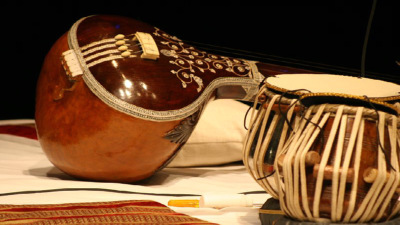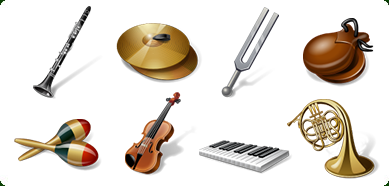- Home
- Culture of India
- Indian Music
Indian Music
Updated on 13-12-2020
Indian Music: Music soothes the mind of a person. It plays a very important role in human life. When a person is depressed or happy he prefers to listen to music. Music existed from time immemorial. Amir Khusroa a great sufi musician and poet, was present in the 13th century.
Like him even Tansen the famous Hindustani musician was present in the 15th and 16th century. From this we can say that music is immortal and immemorial. Indian music has many varieties like classical music, folk music, Jazz, Filmi music, rock music, pop music.
History of Indian Music
The history of Indian Music can be divided into three different phases-ancient, medieval and modern.
Various musical instruments that were used in ancient period have been excavated by the archaeological survey of India. Mesolithic and chalcolithic cave paintings show the use of simple musical instruments like drums, flute etc.
Indian music always had strong ties with mythology and religion. The ancient music in India dates back to Vedas.The archaeological excavation of different ancient sites in India shows us people were conversant with various musical instruments like drums, flute etc.
The famous dancing girl sculpture of Indus Valley Civilization has a drum in her hand. The Samaveda contains musical notations within or above the lines of Samaveda text. It is further said that Samaveda samhita is not read as a text but is sung as a musical note. The Hindu Epic Ramayana does mention dance and music. It is also mentioned in Ramayana of playing different musical instruments by Ravana's wives and Gandarvas.
Another ancient classical Sanskrit text called as Natya Shastras is the base for many classical dance and musical traditional forms. It was written around 500 BC by Bharatha Muni. After Samaveda it is Natya Shastra which deals with music a length.
Bharatha Muni stressed on 22 swara 0ctaves. Even though the concept of raga was not mentioned in Natya Shastra but it suggested jatis or musical modes which is considered as the origin of ragas. It also explains the swaras as vadi, anuvadi,samvadi and vivadi for jati.
The art and the culture in India had serious implications with the advent of Muslims around the 7th century. Most of the Hindu temples were destroyed and many Hindu court musicians were made to vacate the kingdom. But many Muslims rulers like Akbar were great lovers of music and dance and encouraged the artist to a great extent.
During this period the Indian music started to branch into two branches as Carnatic and Hindustani. Even the Persian influence had a huge impact on the Northern style of Hindustani music. The development of Hindustani music reached its peak during the Akbar period.
With the advent of British the music further underwent a change and most court musicians had to go in search of different jobs. There was an influence of pop music on both carnatic and Hindustani music in India. With the development of technology further variations in the music took place like jazz, rock music and hip hop.
Indian Classical Music
Indian classical music has its roots since Vedic period and even before that. Indian classical music has some basic elements known as swara, raga and tala, Shruti. The seven notes of Indian classical music which is known as Sapta swara are Sa, Re Ga Ma Pa Dha ,Ni.The full forms of these are Shadja, Rishabha, Gandhara, Madhyama, Panchama, Dhaivata and Nishada.
A raga is not a tune but many tunes are developed from the same raga. It is basic element of music. These seven swara are the basic and fundamentals of raga. Without this there is no music. There can be variations in these swaras which are known as Komal svara and Tivra svara. If there are no variations then it is called shuddh svara.
There are two main schools of music that are Carnatic music of South India and Hindustani music of North India. Carnatic music developed mainly in the Southern states of Karnataka, Tamil Nadu, Kerala and Andhra Pradesh. The main difference between Carnatic music and Hindustani Music is that Carnatic music emerged from Hindu traditions whereas Hindustani music emerged from the blend of Persian and Islamic influence in North India.
Hindustani music exists in four major different forms namely drupad, khayal, Tumri and Tarana. There are three major schools of tumri that are Lucknow, Banaras and Punjabi gharana. Some of the famous Carnatic musicians include Annamaya who is the first composer in Carnatic music. Indian music is present from Vedic period. Other than Carnatic and Hindustani music Indian music include Folk music, Indian rock music, and Pop music.
Raga:
Raga also spelled as Raag is the most important melodic framework in any music .A raga is based on the scales with a given set of notes. Raga is just not a tune but many tunes can be made from the same raga.
It is believed that a raga can evoke feelings in the audience and can also change the mood of the person. Raga is the most important concept in Carnatic music while ragas in Hindustani are classified according to the moods, season and time. The main goal of raga and the artist is to create feelings with the audience.
Tala:
It is a musical measure with clapping or raising one’s hand for the music. The number of beats may differ from 3 to 128 in the musical performance. The concept of tala is also different in Carnatic and Hindustani music. In the Hindustani music tala appears in two three and four by quickening the tempo of music into Vilambit, Vilamb (2 strokes per beat) and Madhyama (four strokes per beat). The most commonly used tala is carnatic music is Adi tala and while in Hindustani it is teental.
Different types of Indian music
Carnatic music is one of the oldest music in India. Carnatic music predominantly belongs to South Indian states of Karnataka, Tamil Nadu, Andhra Pradesh. Puranadara Dasa who belonged to Karnataka is called as Father of Carnatic music. His song composition is mostly in Kannada while very few are in Sanskrit. Purandara dasa codified the beginners lessons and laid foundation syllabus for learning Carnatic music
Hindustani music: One of the oldest music system that originated in Northern part of India. It is an Indian classical music that was present during 13th and 14th century. If Carnatic music is classical music tradition of southern part of India Hindustani is the classical music tradition of Northern part of India. These two music are the base for Indian classical music. Hindustani music is based on raga while the Carnatic music is based on composition.
Indian Folk music: India is a land of different cultures and diversities. Folk music of India is unique and world famous. Usually folk music is sung in a gathering and during happiness or festivals or for some other celebrations. Even with the different varieties in music like pop, rock music still folk music holds its own unique place in everybody’s heart. Folk music, tribal music and Carnatic music completely differ from one another. Each region has its own folk music.
Ghazals: Ghazal is a poetic form that originated in Arab around 7th century AD. It is mainly famous in India and Pakistan. However now it is more famous as a Urdu song sung by some eminent Gazal singers like Jagit Singh, Gulam Ali and many more. Lyrics are given the utmost importance in Ghazal.
Hindustani Gharanas: Gharanas means Ghar or house. it is a place for learning music from different schools. These schools have their own mode of teaching and each school has its own rules. The teaching and even the performance of each school differ. The singers take the pride of saying to which school they belong to. A gharana can take the name of a place, person.
Indian musical instruments: There are various musical instruments which has lot of importance in music. There are various types as well like string instruments, drums, wind instruments and vibrating instruments called as idiophone. Some important instruments are Veena, Ghatam, Mridangam, Tabla, Sarangi, Sitar, Shehnai, Harmonium, Flute, Pungi or Been.
Update on coronavirus in India
Affiliate Disclosure:
If you make any purchase via a link on this site, I may receive a small commission with no added cost to you.




